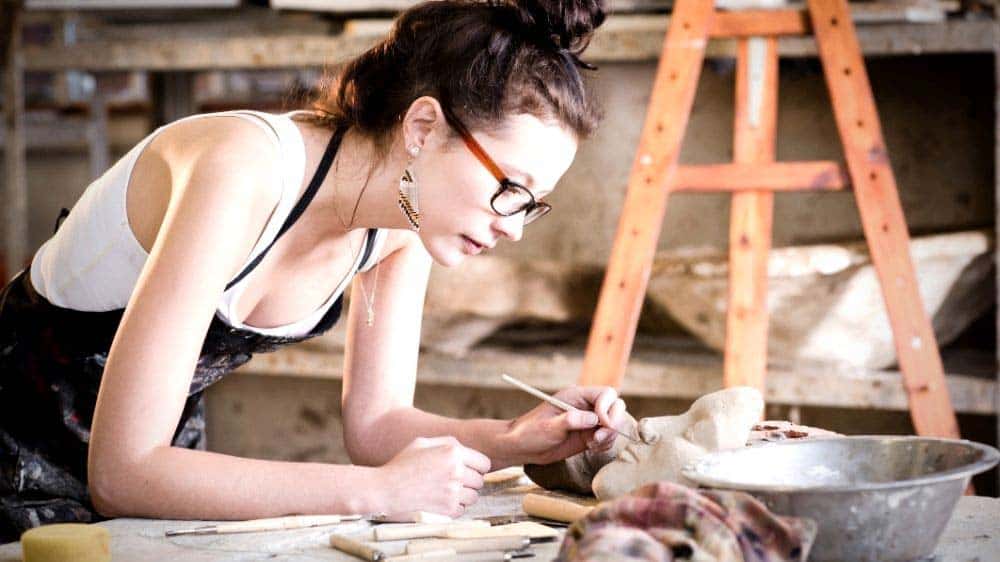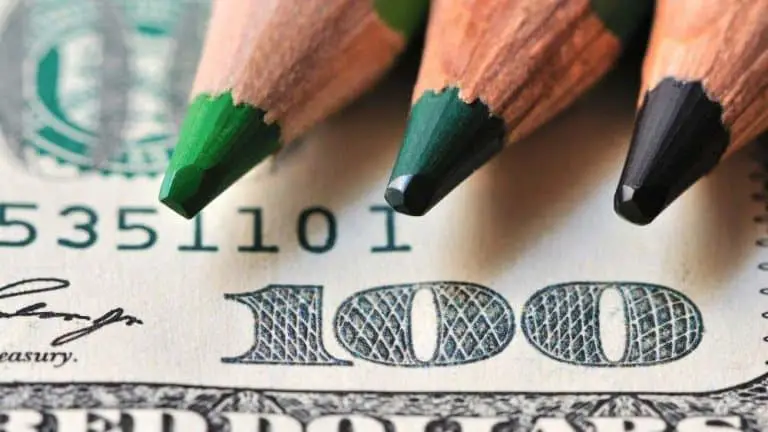Can Artists Be Rich? (How to Succeed as an Artist)
It’s no secret that making a living as an artist can be difficult. Does a working artist today have a chance to build a successful career, or even better, become wealthy from creating art? It’s true the barriers are high but it can, in fact, be done. So if you’re wondering: Can artists be rich? The answer is yes, but it will depend on you and the decisions you make as an artist whether you will succeed or not.
It is quite possible for an artist to become rich and successful. Becoming wealthy as an artist will require equal parts artistic talent, marketing knowledge, and business savvy. Artists that treat their art like a business, and are always on the lookout for opportunities, are the one’s likely to succeed.
The phrase ‘starving artist’ is a notion that has been passed down for generations, and has become almost like a badge of honor in some corners of the art world. Whether an artist is ‘starving’ or not will depend on the individual. This is a preconceived idea, which is embraced by some, and ignored by others. Wealthy artists are the ones who don’t let opinions and unrealistic expectations define them or their work. Keep reading to find out not only how to succeed as an artist, but how to thrive!

(This article may contain affiliate links and I may earn a commission if you make a purchase)
The Starving Artist Stereotype
The ‘starving artist’ usually has an underlying negative attitude and some self-doubt about their creative capabilities. Sure, they want to make it big and have their creative work hanging in prestigious art galleries, but they don’t really want to deal with the business side of things, such as networking and marketing.
This is what I refer to as an ‘artsy fartsy’ artist. This is where an artist has their head in the clouds creating work that strikes their fancy with no regard for the viability of their artistic endeavors in the market.
Can this work? Can you become a successful artist with enviable sales without giving any thought to the mundane business of art? Sure, it happens from time to time. In my experience, however, this is not a winning formula for success. If you approach your art career like this, and it happens to work out, then consider it a happy accident.
Someone with the starving artist mentality may have unrealistic expectations, such as thinking that if they produce good art it will sell itself. Or they kid themselves by claiming that they don’t want to become a sell-out, so they don’t really try to create marketable art and get it sold. In reality, things don’t just happen by themselves, especially when it comes to making money. Many factors contribute to determining an artists’ level of success and income.
Recommended Reading: The Complete Guide to Making Your Art More Sellable (Attn: Artists)
How Do Artists Become Rich and Successful?
Okay, so it’s reality time, and this might hurt a bit, but I’m going to share with you the two things you’ll need to do (or not do) to become a wealthy and successful professional artist.
1) Do Not Rush To Quit Your Day Job
Everybody (me included back in the day) wants to quit their day job and work at their art full-time. As a rule of thumb you should not resign from your current employment to pursue an art career if you have not already established a business that will pay you equal or greater than your current income.
This could put a lot of unwanted financial pressure on you. If you have to worry about whether or not you will be able to pay your bills, you will have difficulty focusing on your creations. The real benefit, however, is that having a regular paycheck, and doing your art on the side, will give you more options to succeed.
When I was a young photographer, I wanted to quit my job so bad. I was tired of working for the man and being on someone else’s time schedule. Once I started making pretty good money with my photography it was tempting to quit on the spot, but I held on to my job for a little while longer. Doing so helped me out by giving me these 3 main benefits:
Better time management skills
As a young artist, I probably wasn’t as disciplined as I needed to be and my job gave me a structure to work around. I knew that I only had so much time to work on my photography projects, and because of this I worked my butt off on lunch breaks, evenings and weekends. Left completely to my own devices, I most likely would have developed a habit of wasting a lot of time.
Health insurance and benefits
Not to be underestimated, my job provided me with health insurance (which would have eaten up a big chunk of my photography earnings early on), and benefits such as paid days off which as I viewed as full-time photography days.
Ability to reinvest my art earnings
Because I had a full-time paycheck to pay the bills, I was able to reinvest my photography earnings 100% back into things that would help advance my budding photography career much faster. Things such as new cameras, lenses, computers, software, and training. I think this provided the most important benefit to me and my eventual long term success as an artist.
2) Consider Your Art A Business
Artists often think of their art as something they do for themselves, and not as a business. However, if you want to make a living from your work, it is important to start thinking about it in business terms.
While spending all of your time creating magnificent works of art may sound ideal, it is likely the quickest route to achieving starving artist status. Steve Jobs may have built the first Apple computer in his garage, but without also taking an active hand in marketing, promotion, sales, billing, manufacturing, shipping, etc. the prototype of the first Mac computer would still be collecting dust in his garage. In order to gain fame, wealth and success, Steve Jobs had to first treat his vision as a business.
Think of any successful independent business person you know and you’ll quickly realize that they had to actively work at many different tasks in order to achieve success. I like to think of these tasks like pistons in a four-cylinder engine. If you are creating amazing art (piston #1), but piston #2 (Promotion), piston #3 (Sales), and piston #4 (Delivery) don’t have the same energy going to them, the car is not going to go anywhere.
The world is full of creative and artistic people. Some make visual art, others make music, some write books, while others design clothing. However, if you don’t approach your art as a business. It will not run efficiently and you will never have the opportunity to become a wealthy successful artist.
If you approach your art endeavors as a business and hang on to that day job for just a bit longer than you’d like, you’ll find that the way to a full-time art career will open to you much faster. The key is to think like an entrepreneur.
Two Main Paths To Choose From In The Art World
1) Fine Art
Fine art artists, sculpt, paint, and create other physical and visual works of art, usually with the goal of being displayed in museums or art galleries. These artists strive to create art that is admired and appreciated for its aesthetic. While they may sell their work to collectors, a fine art artist does not create art for overtly commercial or mass consumption purposes. Their art is original and one-of-a-kind. Fine art works include;
- Paintings
- Sculptures
- Pottery
- Photography
- Drawings
An artist who does fine art usually has a preferred medium and a signature style. They first create the works of art, then through marketing and promotion find buyers who love their artwork and purchase a piece for display in their home or office.
2) Commercial Art
Large companies or organizations usually hire commercial artists to do their advertising, media artwork and creative entertainment. This path focuses more on mass production for the commercial world. This includes;
- Magazine Illustration
- Visual branding
- Video game design
- Cinematography
- Digital Illustration
- Packaging design
- Decorative arts
- Graphic design
Think of fine art as being a private school and commercial art as being a mainstream school. Commercial art and artists are in large demand by companies in every industry, and as such receive a more regular paycheck. They still get to use their creativity, but within the confines of the needs of an end client.
Decide which of these two paths you want to choose, fine art or commercial art. The path you take in art is a very important decision. You will be spending hours every day working on your craft, so it’s worth the time to decide what field of work interests you most and then pursue that direction by educating yourself accordingly.
Recommended Reading: Why Are Art Schools So Expensive? (Explained)
Action Steps: Succeeding as an Independent Artist
Regardless of the path you choose, there are some steps you will need to take (or consider taking) to achieve your full potential as a successful artist. Consider the following steps when building your art business.
Build Your Clientele. This requires you to do research. Find private or large companies who are looking for the type of services that you offer. Do cold emailing to these companies to notify them of your product or service.
Take your time to perfect your art or craft. Although any art medium is acceptable, there is a difference between good quality work and rushed poor quality work. People recognize and appreciate value.
It would help if you had a portfolio to present to your prospective clients. Your portfolio represents you whether you’re an established or an emerging artist, so it needs to be assembled with great care and attention to detail. The client should not be confused about what you do when they look through your portfolio; they should know exactly what you are presenting to them.
Do commission work. If you paint on canvas or draw people’s sketches, you could paint family portraits for clients, apart from your regular artworks. Even sitting in a high traffic public park and doing live paintings and sketches of people walking by will be good exposure. This way, people can see what you do and how you do it.
Create a website and use Social Media. Social media is the best way to market yourself nowadays. The most effective way to let people know about you is by creating a Facebook page, a LinkedIn account, Instagram, and an artist’s website (Squarespace). Have links to all your pages and accounts visible on each of your sites. This way, if they visit one of your pages, they can be linked directly to all your other sites.
Create a channel on Youtube. This is one of the most popular ways for people use to get exposure. If you can create a Youtube channel showcasing your art and how it is made, you will definitely get recognized for your work. As your channel grows in popularity, Youtube will pay you for the views on your videos, so remember to ask your friends to share the link.
You can license your IP (Intellectual Property) Rights to earn a passive income. For example, if you’re a photographer, you could license your photos on Getty Images or other sites that sell photography.
You could use one or more of these popular online platforms to build a branded eCommerce site where you can sell your art;
- Saatchi Art
- UGallery
- Shopify
- TurningArt
- Etsy
- Amazon
- Zazzle
- FineArtAmerica
- Society 6
- Vango
Introduce yourself to galleries or find out when and where there are art festivals. Have business cards (Office Depot) available to anyone interested in your art or service. It helps if you professionally present yourself.
Invite friends on Instagram when your work is being displayed at art exhibitions, events or when you are doing fundraisers and ask them to help spread the news.
Practice the way you talk to others about your work. Be enthusiastic and speak with confidence, not arrogance. Try to avoid speaking in a monotone voice. If people see that you believe in your art, chances are good they will too. The energy that you put out is what will attract clients.
How An Artist Can Make Extra Part-Time Money
Once you go full-time as an artist, it’s still a good idea to secure some part-time side gigs for a bit of extra money. You could consider teaching part-time to earn an extra income. While you are busy marketing yourself, it does not matter if you are a singer or a sculptor; you can teach art classes or be a voice coach for extra income to help build your dream or pay some bills. This will help to alleviate some financial stress while you work on getting yourself out there.
There is art all around us, everywhere we go. The interior decor, the paintings and/or the furniture were all designed by different artists and craftspeople. So, if you do want to be wealthy and successful from your art, you need to get yourself out there and let people know what you can do.
Recommended Reading: 15 Things Art Collectors Look For (Don’t Miss This!)
Successful and Wealthy Artists During Their Lifetimes
- One of the most well-known artists of the Renaissance, Michelangelo di Lodovico Buonarroti Simoni, was quite wealthy. The estate he left behind was worth 50,000 florins, at the time of his death, and reveals the extent of his wealth. That is the equivalent of £35 million today.
- Jacob Collins is an example of a currently successful artist. His artworks range from $5K – $100K, proof that you can become wealthy as a visual artist in this day and age.
- Spanish artist, Pablo Ruiz Picasso’s net worth at the time of his death was estimated to be between $100 million – $250 million. He was especially well known for co-founding the Cubist movement, but he was also a sculptor, ceramicist, and a theatre designer.
In Conclusion
To become rich as an artist will be a challenge. It will take a lot of hard work, determination and perseverance. But if you really believe in your work and you want to make a success of it, you can do it. Stay positive, and take the necessary steps to market yourself and your art business.
You will meet many artists who are on the same journey as you. They will be able to supply you with their connections, and you can help them too. It does not have to be a daunting task to get yourself out there. Think about what you can achieve if you just put in enough hard work—set goals for the future that will motivate you to push harder.
Remember, many artists worldwide have gone from rags-to-riches by giving it all they’ve got. What is stopping you?






